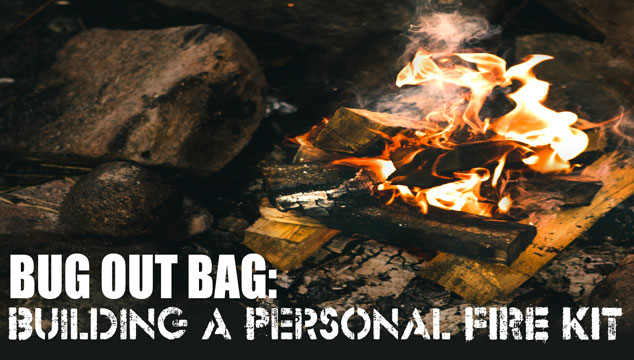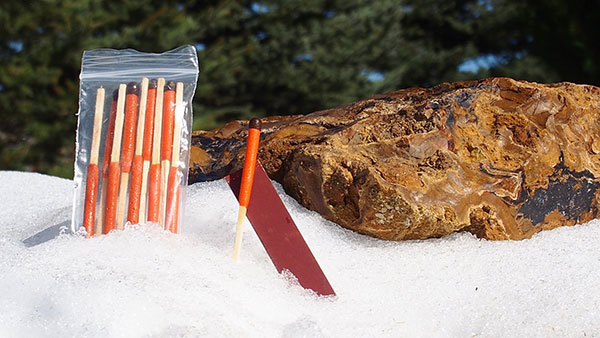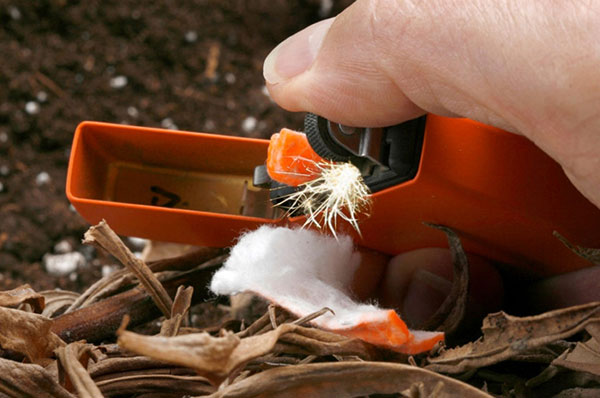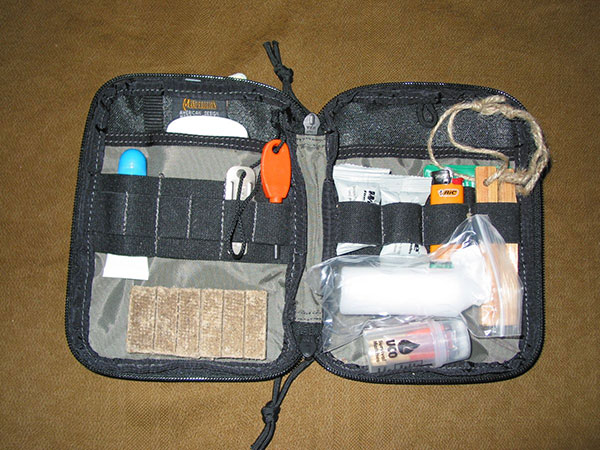
Fire is one of the most important resources you’ll need in a survival situation. You’ll struggle to survive very long in the wilderness without it. Fire will help keep you warmer during cool nights, help illuminate the campsite, be a way to heat food and water, and also helps keep biting insects away. Given this, you’ll always want to have a personal fire kit on your person or in the bug out bag. You can purchase pre-assembled personal fire kits, but it’s easy to make your own. If you make your own, it can be customized.
The Fire Triangle
You need three things to start a fire: oxygen, fuel, and a heat source. These three items create what is called the “fire triangle.” Oxygen is plentiful, so you don’t have to worry about bringing it along. You can find plenty of fuel sources in most natural habitats as well as in urban areas. This can be wood, dry vegetation, scat, and other organic materials. So that means that the most important thing you’ll need in your personal fire kit is a heat source.
Heat Sources for Your Fire Kit
The heat source in your personal fire kit must reach high enough temperatures to ignite the tinder you’re using. Typically, woods must reach temperatures in excess of 400 degrees Fahrenheit to combust. Keep in mind the exact temperature at which combustion is possible varies from one wood to the next.
Tools that produce sparks are effective in this regard, as are cigarette lighters and matches. You can also use a friction fire kit of some variety to produce a coal then use it to ignite your tinder source. Each of these options presents different strengths and weaknesses, so be sure to select the method that best suits your needs.
Matches
Matches are perhaps the best ignition sources available. All personal fire kits should include at least one or two matches. However, not all matches are created equally. Don’t rely on cheap, gas-station matches for your survival needs. Make sure you purchase water-proof, strike-anywhere matches. These will be a lot more likely to work when you’re shivering in a cold, dark forest.

Always use some type of waterproof container to hold your matches. A few zipper-style plastic bags will work if you have no other container for them. But a commercially produced cylinder designed specifically for the task is a better option.
Cigarette Lighter
A cigarette lighter is another option for your fire-starting needs. Although many survivalists may prefer lighters to matches, they are a riskier option. If the flint stops working or the lighter runs out of fuel, you’ll have trouble starting a fire. However, lighters are much more convenient to use than matches. Also you can keep a flame lit with them longer than with matches. This will make it easier to ignite stubborn tinder sources.
Spark-Producing Tools
Commercial fire starters are a very popular option among survivalists and campers. They are lightweight, easy to use, and they’ll work for years. However, there is a bit of skill involved in catching a spark with your tinder source and coaxing it into a flame. It’s always wise to practice using a fire starter before depending upon it.

There are a few different types of fire starters available. These include both flint and steel and ferrocerium versions. Flint and steel spark generators work no matter how damp the conditions are. Keep in mind they require some skill to use. However, most modern survivalists prefer ferrocerium fire starters as they’re easier to use.
Additionally, ferrocerium fire starters produce incredibly hot sparks that may exceed 5,000 degrees Fahrenheit.
Friction Fire Starters
Bow drills, hand drills, and fire saws have been used for thousands of years by primitive cultures. They remain a viable option for modern survivalists. These are all lightweight fire-starting technologies that can be made from raw materials collected from the forest. However, they can be tiring to use and require considerable skill to generate a hot coal.
These types of friction based fire starters work poorly in damp weather. It’s typically wise to bring along a backup method in your bug out bag.
Fire Piston
A fire piston is a small cylinder with a plunger that fits inside it. When you want to start a fire, place a small amount of tinder in the bottom of the cylinder. The plunger is then pressed into the cylinder very quickly. This compresses the air trapped between the plunger and the cylinder. The air becomes very hot, which ignites the tinder and yields a coal.
Fire pistons are very effective fire starters but they can require a bit of skill to use. Be sure to practice using the piston before adding it to your fire kit. It’s imperative that you take good care of your piston as it will stop working if it becomes damaged or damp.
9-Volt Battery and Steel Wool
Touching the leads of a 9-volt battery to a wad of steel wool allows current to pass through the fibers. This will cause them to heat up enough to produce very small, short-lived flames. Touch the glowing steel wool fibers to a source of dry tinder until you succeed in getting the tinder to ignite.

It takes a bit of practice to get the tinder to ignite but it’s easy once you get the hang of it. The drawback to this method is that you need to bring along quite a bit of steel wool. Plus the battery will eventually lose all of its charge. This isn’t a great first line fire starter but it’s an ideal backup solution.
Magnifying Glass
You can start a fire by focusing the sun’s rays on something flammable such as a bit of tinder. However, this is a time-consuming way to start a fire and is only possible when the sun is shining. Accordingly, a magnifying glass makes a good backup ignition source but it’s not a great choice for your primary fire starting strategy.
Of course, magnifying glasses also have other uses so their value isn’t limited to starting fires. But because they are only somewhat helpful and fragile, you don’t want to depend entirely upon them.
Tinder
Usually you’ll be able to find plenty of tinder sources in most natural habitats but it’s always wise to pack a little bit of excellent tinder in your personal fire kit for emergencies. By its very nature tinder is lightweight and most types can be compressed into a very small space. You should always be able to fit a little of it into your kit.
Some of the best emergency tinder sources include:
– Gauze
– Cotton balls
– Lint
– Hair
– Paper
You can pack any of these things in a waterproof container or plastic bag to keep them dry. Just be sure that you keep them completely dry so they’ll work when needed.
Accelerants for Your Fire Kit
Even those skilled in fire starting occasionally have difficulty and it’s wise to have a bit of an accelerant on hand to help get it started. Each of the accelerants listed below will help make it easier to get your tinder to ignite and burn longer. This is especially true in damp weather, when your kindling may need to dry out a bit before it will combust.
The most effective method is to simply add some of the accelerant directly to the tinder before exposing it to an open flame, sparks, or a hot coal.
– Hand sanitizer
– Candle wax
– Melted crayons
– Petroleum jelly
– Cooking oil
It’s smart to make your own fire starters by dipping or coating a tinder source in one of the accelerants listed above. Then simply remove one of your pre-made fire starters, light it with a match, and place it under a bit of kindling.
One of the easiest ways to make fire starters is by coating small paper squares with melted wax. The subscription cards from magazines are ideally suited for this purpose. These fire starters will light easily and burn long enough to get small kindling to combust, even if the wood is slightly damp.
Miscellaneous Items to Round Out Your Fire Kit
In addition to an ignition source, some tinder, and a bit of accelerant, there are a few other things you may want to add to your personal fire kit. Some of the potential items you may want to include are listed below.
Candle
A candle is incredibly helpful for starting a fire or keeping a flame going once you’ve generated one. For example, if you use a flint and steel fire starter, light the candle once you catch a spark and coax the tinder into a flame. If your tinder goes out before it can light the kindling, there’s a flame ready. Additionally, you can simply use the candle to directly light very small and dry kindling.
Flexible Piece of Plastic
Once you’ve got a small fire burning, increase its size by fanning the flames. Although you can do this with a bushy tree branch or article of clothing, a paper-sized piece of plastic is incredibly efficient. Cheap plastic placemats or cutting boards are ideal for the task, weigh almost nothing, and rarely cost more than a dollar.
Hands-Free Flashlight
You’ll often be building a fire in the dark, so a hands-free flashlight can help you see. Note that a regular flashlight that is designed to be held in the hand will be very difficult to use while trying to light a fire with a match. It’s essentially impossible to use while starting a fire with a friction tool or fire piston.
Sandpaper
A small bit of sandpaper can be used to create fine wood dust that can be used as tinder. Make your own impromptu fire starters by adding a bit of oil, fat, pitch, or one of the accelerants from your fire kit to the wood particles. Sandpaper can also help keep the wooden components of a hand drill, bow drill, or fire saw smooth.
Length of Leather or Paracord
A length of leather, paracord, or similar durable cordage is valuable for a multitude of reasons as it relates to fire-starting. Additionally they can all be used as a replacement string for a bow drill. The string is the most likely portion of a bow drill kit to fail so it makes sense to have a backup at the ready.
Carrying Case
Once you have assembled all of the things you need for your personal fire kit. This should include at least an ignition source, a bit of emergency tinder and a small amount of accelerant. Store all of this in some type of container. It will keep everything together and prevent you from having to search when getting a fire started.

There are a variety of different containers and bags that can work well for this purpose. Make sure they’re waterproof and large enough to contain all of your fire-starting equipment. A water tight plastic container is usually a great choice but a glass jar or metal case works too as long as it’s waterproof. You could even use a nylon or leather bag but place the bag in something waterproof to keep your supplies dry.
Final Thoughts
Ultimately, remember that what is needed in a personal fire kit is up to you. It should suit your specific needs and the challenges you’re most likely to face. For example, if you live in an arid, desert-like region, a friction-based fire starter may present a good first-line strategy. You may not even need to pack any accelerant, but your biggest problem will be finding enough fuel. By contrast, someone living in a dense, forested region will be surrounded by fuel at all times. But the ample rain will make it difficult to find suitable tinder. Such survivalists would be much better served by a fire starter that will work while wet, along with plenty of emergency tinder and accelerant.
This article was originally published in Survival Dispatch Insider magazine Volume 3 Issue 9.
=====
Become a Survival Dispatch Insider …
We bring together survival enthusiasts and preppers to share skills and knowledge, so you can enhance your preparedness for emergencies and ensure the safety of you and your community.
The Results You’ll Get …
Our community, courses, and memberships are pretty special. We focus on the ways it will make a huge difference in your life.
Here are a few of the things you’ll be able to do as a member of Survival Dispatch Insider …
1) Improve your emergency preparedness by learning survival skills and strategies from experienced preppers. 2) Build lasting connections with like-minded individuals that share your passion for safety and readiness. 3) Access a wealth of knowledge and resources to assist in protecting you and your community during unexpected situations. Click HERE to get started.
=====
